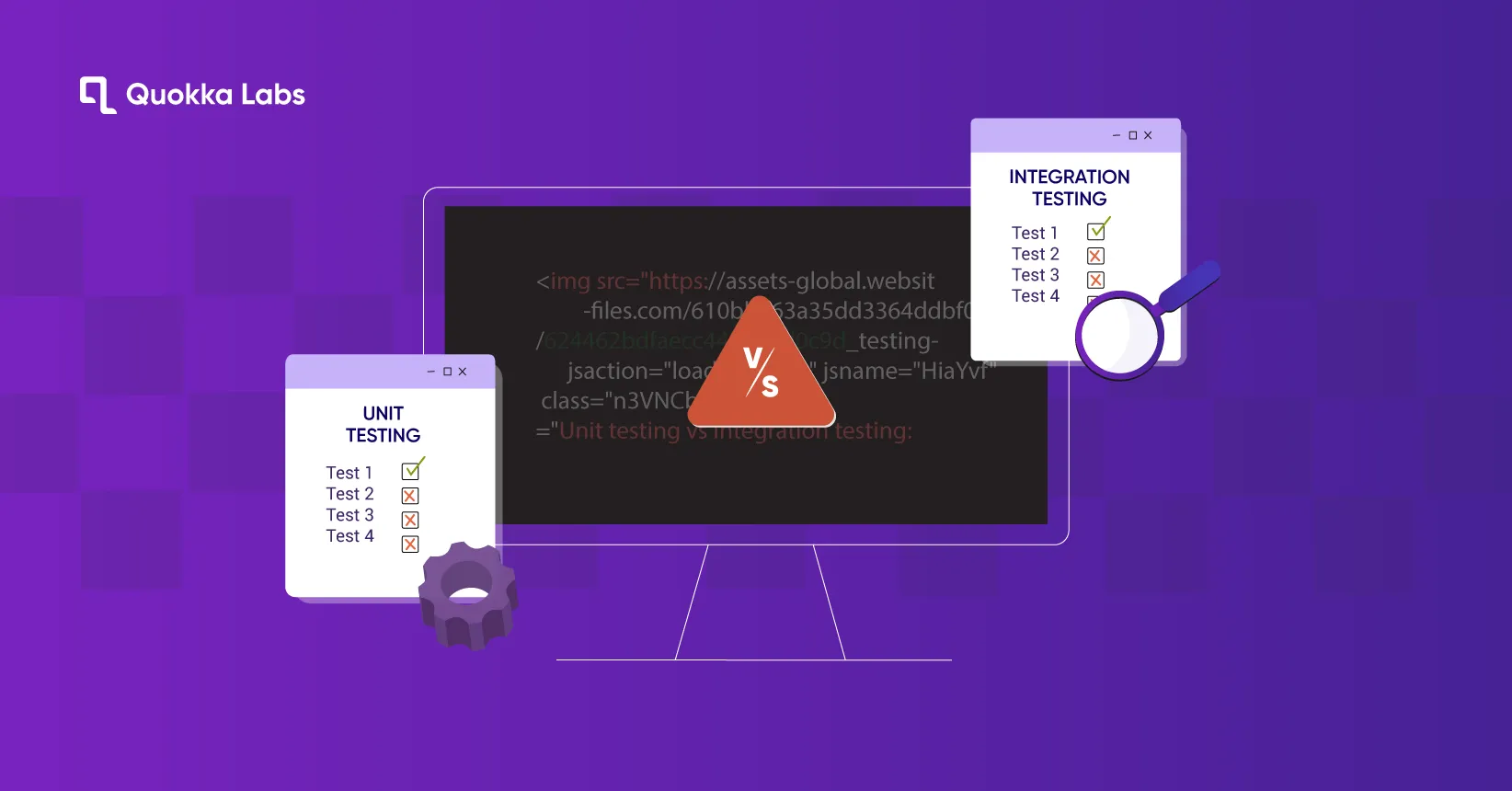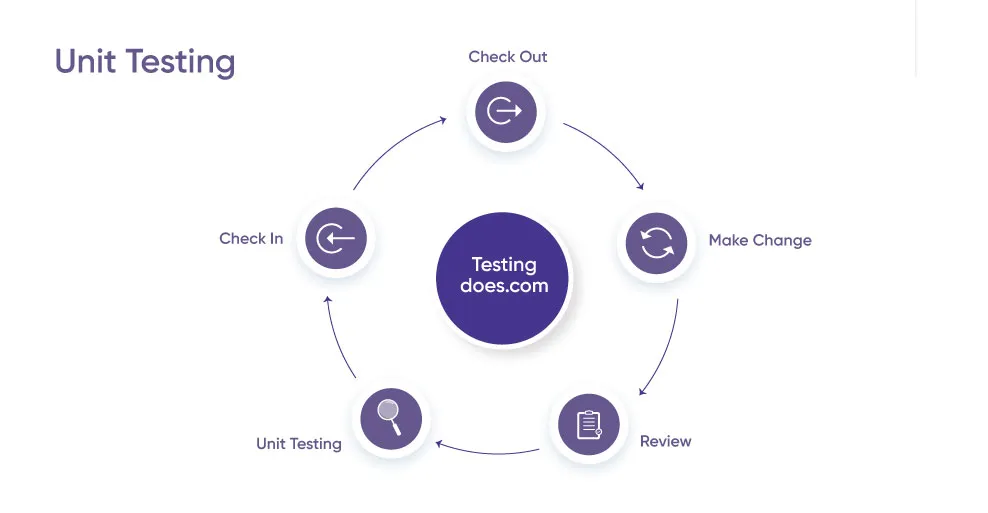Technology

3 min

This blog provides an explanation of unit testing and integration testing, which are crucial parts of the software development life cycle. The blog outlines the differences between the two methods, and the benefits of each. It also offers a list of best unit testing tools, and discusses the various approaches to integration testing. By the end of the blog, readers will have a clear understanding of the importance of unit and integration testing and how they can improve software development.

By Dhruv Joshi
18 Oct, 2022
In the Software Development Life Cycle, various types of methods are used for QA or software testing, like system testing, acceptance testing, quality testing, unit testing, regression testing, etc. But the essential ones are unit testing and integration testing.
In this blog, we will learn how unit testing differs from integration testing, what consumes more time and money, and how they work. After reading this blog, your confusion between those will get rectified.
Let's get started with unit testing first.
Unit testing is a part of the SDLC where individual units or components of a software program are tested to see if they are functioning as expected. An application's most minor testable component is a unit or piece of code. In procedural programming, a unit may be an individual program, function, procedure, etc., while in object-oriented programming, a unit is a particular class, module, or function.

Developers usually write unit tests as they are creating code. They are used to make sure that the code they have written works as expected and to find any bugs before the code is deployed.
Unit tests can be run automatically, and they can also be run manually. When they are run automatically, they are typically run as part of continuous integration or a continuous delivery process.
Unit testing has many benefits, including:
Unit testing is a great way to ensure your code works as intended. You can verify that your code is doing what you expect by writing and running tests. Additionally, unit testing can help you find and fix errors early in development.
Unit testing is crucial for a more extensive system's code. It can help ensure that changes to one part of the code will not break other parts of the system. Unit tests can also be run automatically as part of a continuous integration process, making it easy to catch errors as soon as they are introduced.
Overall, unit testing is a valuable tool for any software development project. It can help you catch errors early, ensure that your code works as intended, and automate the testing process.
Examples:
Integration testing is a type of QA used to verify a system's functionality composed of multiple components or modules. This type of testing is essential because it can help ensure that the various parts of a system work together as intended.

Integration testing can be performed at various levels, such as component level, interface level, and system level. Component-level testing focuses on testing the individual components of a system. In contrast, interface-level testing focuses on testing the interactions between components. System-level testing is the most comprehensive type of integration testing and focuses on testing the system.
Integration testing can be tricky because it can be challenging to determine when all the necessary components are available for testing. In addition, integration testing often requires test stubs and drivers, which can add to the complexity of the process.
Integration testing has three approaches:
Despite these challenges, integration testing is integral to the software development process. It can help ensure that a system is functioning as intended.
As a software development team, it's essential to consider the various types of testing that can be performed on your code. One type of testing that's often overlooked is integration testing.
Integration testing is a type of testing that verifies how different components of your software interact with each other. It is essential because you want to ensure that your software will work as intended when all the pieces are together.
Integration testing is that it can help to identify potential problems early on in the development process. It can save you time and money in the long run, as you can fix issues before they become too costly.
Integration testing can help to ensure that your software is scalable. It is essential to ensure your software can grow with the business.
| Unit Testing | Integration Testing |
|---|---|
| It's a type of testing of small code to see if it's working or not. | It |
| tests different modules to see if they are working together or not. | |
| Checks single component of an app | The behavior of various integration |
| modules is called integration testing. | |
| It covers small code or units; a short code is written for a single testing | |
| class for unit tests. | It covers the whole app and requires more effort to |
| combine all units. | |
| No dependencies on the testing unit. | Dependent on external systems like |
| hardware allocation, databases, etc. | |
| It is the first type of testing in the Software testing life cycle. | It's |
| carried out after unit testing and before system testing. | |
| There are no sub-divisions of it. | Integration testing is divided into |
| three types: big bang, top-down & bottom down. | |
| Module specifications are the first step in unit testing. | The interface |
| specification is the first step in integration testing. | |
| Under unit testing, the detailed visibility of the code is covered. | Under |
| integration testing, the visibility of the integration structure is included. | |
| Focuses on the functionality of units. | Focuses on modules and how they |
| interact with each other. | |
| It comes under the white box testing type. | It comes under both white and |
| black box testing. | |
| Cost-friendly maintenance. | Expensive maintenance. |
| It's easy to find errors. | It's difficult to find errors. |
| Executed by the developer. | Executed by the test team. |
The cost of QA and software testing, especially sub-tests: unit testing and integration testing, can be high. However, the benefits of having high-quality software can be even higher. When done correctly, quality testing can save you time and money in the long run.
Unit testing aims to test individual components of your software to ensure that they are working as expected. This is important because it can help you find and fix bugs before they cause major problems. Integration testing is a bit different; it tests how various components of your software work together. It is essential because it can help you find and fix bugs that only occur when specific parts are used together.
Both unit testing and integration testing can be time-consuming and expensive. However, the benefits of having high-quality software can be even higher. Quality testing saves you time and money in the long run by helping you find and fix bugs before they cause major problems.
All tests are necessary for a software development environment, whether unit testing or integration testing. It's all about ensuring that each code/unit works correctly and that each module interacts smoothly without errors.
No doubt, unit testing is superfast, but integration testing is also integral. Integration testing consumes time and money but assures high-quality software in the long run. I hope you now have a clearer vision of unit testing and integration testing and how unit testing differs from integration testing. Thanks for reading.
Top 11 Must-Have Features of a Custom Web Application in 2026
By Dhruv Joshi
5 min read
Generative AI Tech Stacks: Choosing the Right Tools for Scalable AI Development
By Dhruv Joshi
5 min read
Choosing Best Tech Stack for Web App Development: Performance, Cost, and Scalability
By Dhruv Joshi
5 min read
Top 9 Tech Stacks for Scalable Web Application Development
By Dhruv Joshi
5 min read

Technology

7 min
Generative AI is moving fast into enterprises, from banks to hospitals to government agencies. Adoption is rapid, but security planning lags. Unlike traditional systems, these models can be exploited through prompt injection, poisoned data, or manipulated to leak sensitive information. They are also misused for phishing, deepfakes, and malicious code.


Technology

7 min
AI-powered Web Application Firewalls (WAFs) go beyond static rules by using machine learning, anomaly detection, and predictive analysis to block zero-day threats, reduce false positives, and protect APIs at scale. Unlike traditional WAFs, they self-learn, adapt in real time, and cut operational costs while improving compliance and trust.


Technology

5 min
AI is redefining mobile app security by transforming how threats are detected, tested, and prevented. From continuous monitoring and fraud detection to compliance with regulations, AI ensures apps remain resilient against modern risks. This means safer apps, protected users, and stronger businesses. Investing in AI-driven security today builds trust, drives growth, and secures long-term competitive advantage.


Feeling lost!! Book a slot and get answers to all your industry-relevant doubts